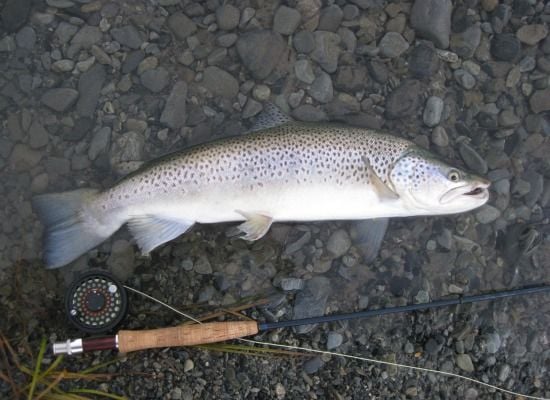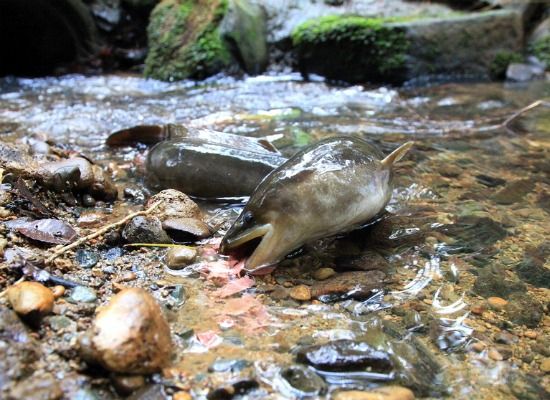Journey to the Bottom of the Earth – Almost
Anyone would be a fool to visit the South Island and not see the cliffs and marine scenery of Milford Sound
/https://tf-cmsv2-smithsonianmag-media.s3.amazonaws.com/filer/20120104103051Milford-SoundSMALL.jpg)
As the Europeans went about settling new lands in the 18th and 19th centuries, there were at least three things they rarely left home without: grapevines, rats and brown trout. The last–Salmo trutta--is a favorite quarry of fishermen everywhere. Though native to western Eurasia, brown trout have been released into watersheds around the globe–but in few places have they thrived, flourished and conquered as they have in New Zealand. Seeing that I’m flying tomorrow to Christchurch, my fly rod is packed.
Years have passed since I’ve taken a proper cast at a wild trout, and now I must step back into the water, for both the North and the South islands of New Zealand host thriving populations of brown trout almost implausibly large and abundant. The fish first arrived in 1867–the brood of English stock–and they took to the almost countless streams and lakes of New Zealand like Himalayan blackberries along an American highway. The browns grew huge–especially at first–sometimes weighing well over 20 pounds, and as they multiplied, they also dispersed; they went to sea, swam up and down the coasts and nosed their way into virgin rivers where few, if any, salmonids had gone before. They devoured local species and generally reset the balance of New Zealand’s aquatic ecosystems. Over time, the brown trout collectively sized down, and today they average three to five pounds–still, very big, and a huge tourist draw. Loved though they are, browns are an invasive species–and in places the government is dealing with them as a pest.
We’ll be touring New Zealand with a guide. His name is Andrew. He’s my brother. He traveled here last January and tells us anyone would be a fool to visit the South Island and not see the cliffs and marine scenery of Milford Sound, perhaps the closest thing the real world knows to the fabled “Cliffs of Insanity” that Andre the Giant and several friends scaled in the film The Princess Bride. The sheer walls of rock that plunge into the deep waters here also skyrocket out of sight, as boatloads of tourists gape from below. Cameras barely do justice in Milford Sound.
Elsewhere in the wilderness of Fiordland National Park, there are few, if any, roads, and the adventurous traveler faces the tempting prospect of vanishing into the mountainous temperate rainforests. From the ocean on the west side and Lake Te Anau on the east, fjords penetrate deep into the Southern Alps of the national park, and Andrew and I are speculating whether to paddle kayaks into Te Anau’s western arms, which wind deep into wild country that few people on Earth ever see.
In our baggage we also have snorkeling gear and wetsuits, with plans to spend many days in the ocean collecting the paua–that’s local vernacular for what most English speakers call abalone–which cling to tidal and subtidal rocks almost as abundantly as barnacles in places. So promises Andrew, who also tells me that the traveler who arrives at a hostel bearing a sack of paua for the cast iron (or a large brown trout for the broiler) is a man for whom new friends will soon arrive.

And we’ve packed rain gear. Though we go to New Zealand in the peak of summer, it won’t be dry; the South Island extends into high enough latitude – as far south as 46 degrees – that it intercepts the wettest of westerlies weather much like coastal Oregon and Washington do. Annual rainfall can exceed 300 inches in parts of Fiordland, and if the skies are persistently gray, there’s always the drier, warmer wine country.
Other attractions in New Zealand:
Marlborough Sounds Maritime Park. A second-best by some opinions to Fiordland National Park, this immense region of islands and inlets is located in the very north of the South Island and receives just a fraction of the rainfall that soaks the South Island’s west coast. Towns and villages, and warmer waters, make it altogether a more hospitable place.
Longfin eel. These beasts prowl many of the waterways of New Zealand–and fly fishermen regularly spot them snaking through the shallows along the shoreline. Though seen as fair game by some fishermen, the eels, which may live for a century and grow to six feet, are also a beloved artifice of natural heritage and a declining species, imperiled by destruction of watersheds.

The glaciers. In the Southern Alps, glaciers like Fox and Franz Josef invite tourists and trekkers to see and even venture onto these massive flows of ice, each remarkable for their relatively low latitude and elevation; both terminate at less than 1,000 feet of elevation, amidst temperate rainforest. Also remarkable, as climate change impacts other glaciers in New Zealand and rest of the world, Fox and Franz Josef glaciers have actually advanced in recent years.
Dolphins at Kaikoura. At this small east coast cape north of Christchurch, tourists may enter the water and swim with groups of the dusky dolphin. The dolphins show no fear of their admirers and will swim within yards of submerged divers, yet just how Kaikoura’s dolphin diving industry may be impacting the animals themselves has become a matter of concern.
The Great Walks. More than a dozen famed hiking trails on the North and South islands take walkers through some of New Zealand’s most tremendous scenery. The Milford Track, for one, leads trekkers deep into the wilds of Fiordland. Due to intense pressure, applications and permits and required for some of the Great Walks.
Kiwi Bird. The five species of New Zealand’s most famous wild creature, in the genus Apteryx, are all endangered. Stewart Island, a wet wilderness off the southern tip of the South Island, offers the best kiwi viewing opportunities.
Planning Your Next Trip?
Explore great travel deals
Smithsonian magazine participates in affiliate link advertising programs. If you purchase an item through these links, we receive a commission.
/https://tf-cmsv2-smithsonianmag-media.s3.amazonaws.com/accounts/headshot/Off-Road-alastair-bland-240.jpg)
/https://tf-cmsv2-smithsonianmag-media.s3.amazonaws.com/accounts/headshot/Off-Road-alastair-bland-240.jpg)